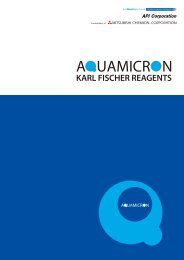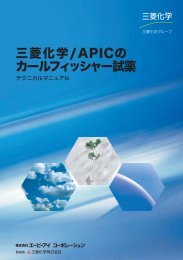Development of Karl Fischer Reagents
Development of Karl Fischer Reagents
Development of Karl Fischer Reagents
Create successful ePaper yourself
Turn your PDF publications into a flip-book with our unique Google optimized e-Paper software.
III-2. Foodstuffs<br />
Chapter III: Applications - 2<br />
The food category encompasses a wide range <strong>of</strong> substances with varying<br />
properties.<br />
It includes agricultural, livestock and marine products and processed<br />
products, as well as food additives. The moisture content <strong>of</strong> these items also<br />
varies widely. It is necessary, therefore, to select the most appropriate<br />
sample handling procedures and measurement method for each individual<br />
product.<br />
Test methods for foodstuffs are mostly stipulated in the JAS standards. In<br />
most cases moisture content is measured using heating and drying<br />
methods, but <strong>Karl</strong> <strong>Fischer</strong> titration is specified for some items. In the case <strong>of</strong><br />
chemically defined foodstuffs, such as sugars and additives, <strong>Karl</strong> <strong>Fischer</strong><br />
titration can be applied using the same methods as for normal chemicals.<br />
Food items with complex structures, such as cereals and meats, contain not<br />
only adhesion moisture but also moisture incorporated within cells.<br />
Measurement results for these items are provided for your information.<br />
Because many food items do not dissolve in organic solvents, the moisture<br />
vaporization method is used extensively. However, foodstuffs commonly<br />
become unstable when heated, and water may be formed as substances<br />
break down. Care must be taken, therefore, when setting analytical<br />
conditions.<br />
1. Food Additives and Flavorings<br />
Key Points<br />
Food additives are substances used in the manufacture, processing<br />
and preservation <strong>of</strong> foodstuffs. There are many types with varying<br />
attributes. Most are solid, but those that dissolve in dehydrated solvents<br />
or electrolytes can be titrated directly using <strong>Karl</strong> <strong>Fischer</strong> titration.<br />
However, it is necessary first to determine whether or not interference<br />
substances are present. Direct titration should be avoided in the case<br />
<strong>of</strong> insoluble substances, and the moisture vaporization method is<br />
recommended. As the moisture content <strong>of</strong> these substances is<br />
generally high, volumetric titration is used.<br />
However, coulometric titration can also be used if the sample quantity is<br />
kept small.<br />
When using moisture vaporization, it is necessary to set the<br />
measurement conditions after determination <strong>of</strong> the heating temperature.<br />
Official specifications for food additives commonly stipulate the loss-ondrying<br />
method, so conformance with that method should be checked.<br />
167




